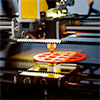| Oct 08, 2021 |
|
|
|
(Nanowerk News) Researchers at Loughborough University have developed a hybrid method called Material Treatment Extrusion Additive Manufacturing (MaTrEx-AM), which uses acetone to toughen targeted layers of 3D printed parts and structures (Additive Manufacturing, “MaTrEx-AM: a new hybrid additive manufacturing process to selectively control mechanical properties”).
|
|
Varying how much acetone is applied and where it is used allows manufacturers to create items with novel mechanical properties, such controlling how parts deform.
|
|
The ability to create these time-dependent gives the printing process a 4D aspect.
|
|
Real-world applications include 4D lattices for helmet padding to avoid impact injuries and for biomedical implants.
|
|
DrAndy Gleadallsaid: “The process adds material layer-by-layer – there are grooves between the layers, a bit like you’d see if you stacked lot of logs sideways on top of one another, all lined up.
|
|
“3D printed parts are often weak because of the way layers are laid down in sequence, so there are geometric defects between the layers and the bonding of material between layers may not be as good as the pure polymer.
|
|
“The new capabilities are potentially valuable for a huge range of parts and structures, but perhaps most obvious ones would be parts that deform during operation and the way in which they deform needs to be controlled.
|
|
“The time-dependent nature of mechanical properties means the approach adds a new dimension to material capabilities, with in-situ hybrid processing facilitating a true 4D printing process.”
|
